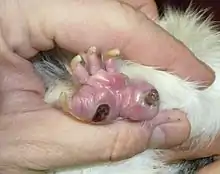Bumblefoot (infection)
Bumblefoot (ulcerative pododermatitis) is a bacterial infection and inflammatory reaction on the feet of birds, rodents, and rabbits.[1] Ulcerative pododermatitis is referred to as "sore hocks" when it affects a rabbit and "bumblefoot" when it affects a bird.[1] The terms "sore hocks" and "bumblefoot" are used interchangeably when describing ulcerative pododermatitis in rodents.[1] The infection can usually be attributed to poor husbandry practices,[1][2] and is therefore much more likely to occur in captive animals than in those in the wild. It is caused by bacteria, namely strains of Staphylococcus, Pseudomonas and Escherichia coli (E. coli), with S. aureus being the most common cause of the infection.[1]

Bumblefoot on birds of prey
Bumblefoot is, perhaps, the largest cause of referral of birds of prey to a veterinary surgeon. Bumblefoot on birds of prey can be put into three broad types of the infection. In the first type, a small reddened area, or sometimes a small shiny patch, can be seen on the foot. This is mostly caused by inappropriate perching (or perching for too long), or less likely, by badly fitted furniture, such as jesses that are too small. The second type is more serious, where an infection has penetrated the skin. The third type involves the bird having a severe distortion of the contours of the foot and/or the toes, resulting in considerable damage to the foot. A bird suspected of suffering from any degree of bumblefoot should be assessed by an avian vet and prescribed antibiotics if deemed necessary.
Bumblefoot in poultry and waterfowl
Bumblefoot is a common infection for domesticated poultry and waterfowl such as chickens, ducks and quail. Due to constant walking on hard, rough, or sharp surfaces, birds can develop small wounds on the bottom of their feet.[2] These wounds are very susceptible to infection by opportunistic bacterial pathogens, chiefly Staphylococcus aureus.[2] Treatment often requires opening the wound to drain the pus, soaking it in epsom salts, and antibiotic treatment and local application of the antiseptic povidone-iodine as local dressing.
Bumblefoot in penguins
In 2016, thermography was used to identify and evaluate bumblefoot lesions in 67 captive penguins from three species.[3]
Etymology
Bumblefoot is so named because of the characteristic "bumbles" or lesions, as well as swelling of the foot pad, symptomatic of an infection. Topical antiseptics in addition to oral or injected antibiotics may be used to combat the infection, which if left untreated may be fatal.[4]
References
- Blair, Jennifer (19 September 2013). "Bumblefoot: A Comparison of Clinical Presentation and Treatment of Pododermatitis in Rabbits, Rodents and Birds". In Fisher, Peter G. (ed.). Select Topics in Dermatology. Veterinary Clinics of North America: Exotic Animal Practice. 16. Elsevier Health Sciences. pp. 715–736. doi:10.1016/j.cvex.2013.05.002. ISBN 978-0-323-18876-0. ISSN 1094-9194. PMID 24018034.
- Pitesky, Maurice (2 August 2016). "The Dirt on Bumblefoot". Acreage Life. Heartland Communications Group. Archived from the original on 29 May 2018. Retrieved 20 March 2017.
- Duncan, Ann E.; Torgerson-White, Lauri L.; Allard, Stephanie M.; Schneider, Tom (1 June 2016). "An Evaluation of Infrared Thermography for Detection of Bumblefoot (Pododermatitis) in Penguins". Journal of Zoo and Wildlife Medicine. 47 (2): 474–485. doi:10.1638/2015-0199.1. PMID 27468019. S2CID 41847620.
- McArthur, Jan (July–August 1998). "Ulcerative Pododermatitis... AKA Bumblefoot & Squeaky". Rat & Mouse Gazette. Rat & Mouse Club of America. Retrieved 29 July 2006.
Further reading
- Ford, Emma (1992). Falconry; Art and Practice. Cassell & Co. pp. 39–40.
